Decadal Trends and Drivers of Dust Emissions in East Asia: Integrating Statistical and SHAP-Based Interpretability Approaches
Abstract
1. Introduction
2. Materials and Methods
2.1. Study Area
2.2. Remote Sensing Data
2.2.1. GlobeLand30
2.2.2. NDVI
2.3. Reanalysis Data
2.3.1. MERRA-2
Dust Emission Bin003 + Dust Emission Bin004 + Dust Emission Bin005
2.3.2. GLDAS
2.3.3. ERA5
2.4. Climate Indices
2.5. Methods
2.5.1. Theil–Sen Median Trend Analysis and the Mann–Kendall Test
2.5.2. XGBoost Regression and SHAP Values
3. Results
3.1. Spatiotemporal Variation of Dust Emissions
3.2. SHAP-Based Attribution Analysis of Dust Emissions
3.3. The Spatiotemporal Correlations Between Key Factors and Dust Emissions
3.3.1. Land Surface Conditions
3.3.2. Near-Surface Meteorological Factors
3.3.3. Atmospheric Circulation Patterns
3.3.4. Climate Indices
4. Discussion
5. Conclusions
- (1)
- From 1980 to 2023, dust emissions in East Asia exhibited significant spatial and seasonal variations, primarily concentrated in the S1, S4, S5, and S6 regions. Among these, S4 was the strongest dust source, with an average contribution rate of 38.1%, peaking at 40.7% during 1991–2001. S5 and S6 followed, contributing 17.0% and 18.8%, respectively. Outside of China, Mongolia (S1) was the most important dust source, with an average contribution rate of 13.8%. Seasonally, dust emissions in East Asia increased significantly in spring, peaking in April, while remaining at lower levels during winter. In terms of trends, dust emissions generally showed a declining trend from 1980 to 2001. Between 2001 and 2012, the decline slowed, and emissions increased in some areas. From 2012 to 2023, dust emissions in the S1 region rose significantly.
- (2)
- SHAP analysis indicates that near-surface meteorological factors are the primary drivers of dust emissions (contributing 49.4–68.8%), with WS and BLH being the most critical factors. The impact of WS is significant across all regions but is modulated by other factors; low BLH enhances the driving effect of WS, while high BLH weakens it. There are notable regional and seasonal differences in driving factors: in the S1 region, atmospheric circulation (e.g., GH_850) dominates in summer, while near-surface meteorological factors prevail in winter and spring; in the S4 region, local meteorological conditions dominate year-round with minimal seasonal variation; in the S5 and S6 regions, WS and BLH are the main drivers, but the influence of atmospheric circulation increases during summer. These findings reveal the regional, seasonal, and complex mechanisms driving dust emissions.
- (3)
- Based on interannual variations and correlation analysis, WS is identified as the primary influencing factor for dust emissions across all regions. RH shows a significant negative correlation with dust emissions in the S5 and S6 regions, indicating that lower humidity conditions are more conducive to dust activity. Among surface conditions, SM has the most significant impact in the S4 and S5 regions, with correlation coefficients of 0.719 and 0.508, respectively. Tsoil also exerts a notable influence in the S4 region (R = 0.663) but has a weaker effect in the S6 region (R = 0.289). Regarding atmospheric circulation, MSLP exhibits the strongest negative correlation with dust emissions in the S4 and S5 regions (R = −0.727 and R = −0.714), suggesting that cyclonic activity significantly enhances wind erosion. Additionally, the negative phases of the AO and NAO significantly promote dust emissions in the S1 and S6 regions by intensifying cold air activity and wind speed, with correlation coefficients of −0.576 and −0.578, respectively.
Supplementary Materials
Author Contributions
Funding
Data Availability Statement
Acknowledgments
Conflicts of Interest
References
- Song, H.; Wang, K.; Zhang, Y.; Hong, C.; Zhou, S. Simulation and Evaluation of Dust Emissions with WRF-Chem (v3.7.1) and Its Relationship to the Changing Climate over East Asia from 1980 to 2015. Atmos. Environ. 2017, 167, 511–522. [Google Scholar] [CrossRef]
- Shao, Y.; Wyrwoll, K.-H.; Chappell, A.; Huang, J.; Lin, Z.; McTainsh, G.H.; Mikami, M.; Tanaka, T.Y.; Wang, X.; Yoon, S. Dust Cycle: An Emerging Core Theme in Earth System Science. Aeolian Res. 2011, 2, 181–204. [Google Scholar] [CrossRef]
- Liu, X.; Song, H.; Lei, T.; Liu, P.; Xu, C.; Wang, D.; Yang, Z.; Xia, H.; Wang, T.; Zhao, H. Effects of Natural and Anthropogenic Factors and Their Interactions on Dust Events in Northern China. CATENA 2021, 196, 104919. [Google Scholar] [CrossRef]
- Perlwitz, J.; Tegen, I.; Miller, R.L. Interactive Soil Dust Aerosol Model in the GISS GCM: 1. Sensitivity of the Soil Dust Cycle to Radiative Properties of Soil Dust Aerosols. J. Geophys. Res. Atmos. 2001, 106, 18167–18192. [Google Scholar] [CrossRef]
- Sokolik, I.N.; Toon, O.B.; Bergstrom, R.W. Modeling the Radiative Characteristics of Airborne Mineral Aerosols at Infrared Wavelengths. J. Geophys. Res. Atmos. 1998, 103, 8813–8826. [Google Scholar] [CrossRef]
- Miller, R.L.; Tegen, I. Climate Response to Soil Dust Aerosols. J. Clim. 1998, 11, 3247–3267. [Google Scholar] [CrossRef]
- Liao, H.; Seinfeld, J.H. Radiative Forcing by Mineral Dust Aerosols: Sensitivity to Key Variables. J. Geophys. Res. Atmos. 1998, 103, 31637–31645. [Google Scholar] [CrossRef]
- Creamean, J.M.; Suski, K.J.; Rosenfeld, D.; Cazorla, A.; DeMott, P.J.; Sullivan, R.C.; White, A.B.; Ralph, F.M.; Minnis, P.; Comstock, J.M.; et al. Dust and Biological Aerosols from the Sahara and Asia Influence Precipitation in the Western U.S. Science 2013, 339, 1572–1578. [Google Scholar] [CrossRef]
- Singh, R.P.; Prasad, A.K.; Kayetha, V.K.; Kafatos, M. Enhancement of Oceanic Parameters Associated with Dust Storms Using Satellite Data. J. Geophys. Res. Oceans 2008, 113, 2008JC004815. [Google Scholar] [CrossRef]
- Zhang, X.Y.; Gong, S.L.; Zhao, T.L.; Arimoto, R.; Wang, Y.Q.; Zhou, Z.J. Sources of Asian Dust and Role of Climate Change versus Desertification in Asian Dust Emission. Geophys. Res. Lett. 2003, 30, 2003GL018206. [Google Scholar] [CrossRef]
- Middleton, N.J. Desert Dust Hazards: A Global Review. Aeolian Res. 2017, 24, 53–63. [Google Scholar] [CrossRef]
- Wang, N.; Chen, J.; Zhang, Y.; Xu, Y.; Yu, W. The Spatiotemporal Characteristics and Driving Factors of Dust Emissions in East Asia (2000–2021). Remote Sens. 2023, 15, 410. [Google Scholar] [CrossRef]
- Filonchyk, M.; Peterson, M.P.; Zhang, L.; Yan, H. An Analysis of Air Pollution Associated with the 2023 Sand and Dust Storms over China: Aerosol Properties and PM10 Variability. Geosci. Front. 2024, 15, 101762. [Google Scholar] [CrossRef]
- Aili, A.; Xu, H.; Kasim, T.; Abulikemu, A. Origin and Transport Pathway of Dust Storm and Its Contribution to Particulate Air Pollution in Northeast Edge of Taklimakan Desert, China. Atmosphere 2021, 12, 113. [Google Scholar] [CrossRef]
- Wang, X.; Liu, J.; Che, H.; Ji, F.; Liu, J. Spatial and Temporal Evolution of Natural and Anthropogenic Dust Events over Northern China. Sci. Rep. 2018, 8, 2141. [Google Scholar] [CrossRef]
- Wu, C.; Lin, Z.; Liu, X.; Li, Y.; Lu, Z.; Wu, M. Can Climate Models Reproduce the Decadal Change of Dust Aerosol in East Asia? Geophys. Res. Lett. 2018, 45, 9953–9962. [Google Scholar] [CrossRef]
- Shao, Y.; Klose, M.; Wyrwoll, K. Recent Global Dust Trend and Connections to Climate Forcing. J. Geophys. Res. Atmos. 2013, 118, 11107–11118. [Google Scholar] [CrossRef]
- Ginoux, P.; Prospero, J.M.; Gill, T.E.; Hsu, N.C.; Zhao, M. Global-scale Attribution of Anthropogenic and Natural Dust Sources and Their Emission Rates Based on MODIS Deep Blue Aerosol Products. Rev. Geophys. 2012, 50, 2012RG000388. [Google Scholar] [CrossRef]
- Huang, J.; Wang, T.; Wang, W.; Li, Z.; Yan, H. Climate Effects of Dust Aerosols over East Asian Arid and Semiarid Regions. J. Geophys. Res. Atmos. 2014, 119, 11398–11416. [Google Scholar] [CrossRef]
- Kok, J.F.; Ridley, D.A.; Zhou, Q.; Miller, R.L.; Zhao, C.; Heald, C.L.; Ward, D.S.; Albani, S.; Haustein, K. Smaller Desert Dust Cooling Effect Estimated from Analysis of Dust Size and Abundance. Nat. Geosci. 2017, 10, 274–278. [Google Scholar] [CrossRef]
- An, L.; Che, H.; Xue, M.; Zhang, T.; Wang, H.; Wang, Y.; Zhou, C.; Zhao, H.; Gui, K.; Zheng, Y.; et al. Temporal and Spatial Variations in Sand and Dust Storm Events in East Asia from 2007 to 2016: Relationships with Surface Conditions and Climate Change. Sci. Total Environ. 2018, 633, 452–462. [Google Scholar] [CrossRef]
- Pu, W.; Wang, X.; Zhang, X.; Ren, Y.; Shi, J.-S.; Bi, J.-R.; Zhang, B.-D. Size Distribution and Optical Properties of Particulate Matter (PM10) and Black Carbon (BC) during Dust Storms and Local Air Pollution Events across a Loess Plateau Site. Aerosol Air Qual. Res. 2015, 15, 2212–2224. [Google Scholar] [CrossRef]
- Yang, Y.; Russell, L.M.; Lou, S.; Liao, H.; Guo, J.; Liu, Y.; Singh, B.; Ghan, S.J. Dust-Wind Interactions Can Intensify Aerosol Pollution over Eastern China. Nat. Commun. 2017, 8, 15333. [Google Scholar] [CrossRef] [PubMed]
- Liu, X.; Yin, Z.; Zhang, X.; Yang, X. Analyses of the Spring Dust Storm Frequency of Northern China in Relation to Antecedent and Concurrent Wind, Precipitation, Vegetation, and Soil Moisture Conditions. J. Geophys. Res. Atmos. 2004, 109, 2004JD004615. [Google Scholar] [CrossRef]
- Munkhtsetseg, E.; Shinoda, M.; Gillies, J.A.; Kimura, R.; King, J.; Nikolich, G. Relationships between Soil Moisture and Dust Emissions in a Bare Sandy Soil of Mongolia. Particuology 2016, 28, 131–137. [Google Scholar] [CrossRef]
- Yin, Z.; Wan, Y.; Zhang, Y.; Wang, H. Why Super Sandstorm 2021 in North China? Natl. Sci. Rev. 2022, 9, nwab165. [Google Scholar] [CrossRef] [PubMed]
- Zou, X.K.; Zhai, P.M. Relationship between Vegetation Coverage and Spring Dust Storms over Northern China. J. Geophys. Res. Atmos. 2004, 109, 2003JD003913. [Google Scholar] [CrossRef]
- Abulaiti, A.; Kimura, R.; Shinoda, M.; Kurosaki, Y.; Mikami, M.; Ishizuka, M.; Yamada, Y.; Nishihara, E.; Gantsetseg, B. An Observational Study of Saltation and Dust Emission in a Hotspot of Mongolia. Aeolian Res. 2014, 15, 169–176. [Google Scholar] [CrossRef]
- Xu, C. Spatiotemporal Variations and Driving Factors of Dust Storm Events in Northern China Based on High-Temporal-Resolution Analysis of Meteorological Data (1960-2007). Environ. Pollut. 2020, 260, 114084. [Google Scholar] [CrossRef]
- Guo, J.; Lou, M.; Miao, Y.; Wang, Y.; Zeng, Z.; Liu, H.; He, J.; Xu, H.; Wang, F.; Min, M.; et al. Trans-Pacific Transport of Dust Aerosols from East Asia: Insights Gained from Multiple Observations and Modeling. Environ. Pollut. 2017, 230, 1030–1039. [Google Scholar] [CrossRef]
- Kaskaoutis, D.G.; Houssos, E.E.; Solmon, F.; Legrand, M.; Rashki, A.; Dumka, U.C.; Francois, P.; Gautam, R.; Singh, R.P. Impact of Atmospheric Circulation Types on Southwest Asian Dust and Indian Summer Monsoon Rainfall. Atmos. Res. 2018, 201, 189–205. [Google Scholar] [CrossRef]
- Mao, R.; Gong, D.; Bao, J.; Fan, Y. Possible Influence of Arctic Oscillation on Dust Storm Frequency in North China. J. Geogr. Sci. 2011, 21, 207–218. [Google Scholar] [CrossRef]
- Gong, S.L.; Zhang, X.Y.; Zhao, T.L.; Zhang, X.B.; Barrie, L.A.; McKendry, I.G.; Zhao, C.S. A Simulated Climatology of Asian Dust Aerosol and Its Trans-Pacific Transport. Part II: Interannual Variability and Climate Connections. J. Clim. 2006, 19, 104–122. [Google Scholar] [CrossRef]
- Fan, K.; Wang, H. Dust Storms in North China in 2002: A Case Study of the Low Frequency Oscillation. Adv. Atmos. Sci. 2007, 24, 15–23. [Google Scholar] [CrossRef]
- Yang, Y.; Zeng, L.; Wang, H.; Wang, P.; Liao, H. Dust Pollution in China Affected by Different Spatial and Temporal Types of El Niño. Atmos. Chem. Phys. 2022, 22, 14489–14502. [Google Scholar] [CrossRef]
- Xu, F.; Wang, S.; Li, Y.; Feng, J. Synergistic Effects of the Winter North Atlantic Oscillation (NAO) and El Niño–Southern Oscillation (ENSO) on Dust Activities in North China during the Following Spring. Atmos. Chem. Phys. 2024, 24, 10689–10705. [Google Scholar] [CrossRef]
- Grell, G.A.; Peckham, S.E.; Schmitz, R.; McKeen, S.A.; Frost, G.; Skamarock, W.C.; Eder, B. Fully Coupled “Online” Chemistry within the WRF Model. Atmos. Environ. 2005, 39, 6957–6975. [Google Scholar] [CrossRef]
- Giorgi, F.; Coppola, E.; Solmon, F.; Mariotti, L.; Sylla, M.; Bi, X.; Elguindi, N.; Diro, G.; Nair, V.; Giuliani, G.; et al. RegCM4: Model Description and Preliminary Tests over Multiple CORDEX Domains. Clim. Res. 2012, 52, 7–29. [Google Scholar] [CrossRef]
- Nickovic, S.; Kallos, G.; Papadopoulos, A.; Kakaliagou, O. A Model for Prediction of Desert Dust Cycle in the Atmosphere. J. Geophys. Res. Atmos. 2001, 106, 18113–18129. [Google Scholar] [CrossRef]
- Huang, J.; Minnis, P.; Chen, B.; Huang, Z.; Liu, Z.; Zhao, Q.; Yi, Y.; Ayers, J.K. Long-range Transport and Vertical Structure of Asian Dust from CALIPSO and Surface Measurements during PACDEX. J. Geophys. Res. Atmos. 2008, 113, 2008JD010620. [Google Scholar] [CrossRef]
- Kok, J.F.; Mahowald, N.M.; Fratini, G.; Gillies, J.A.; Ishizuka, M.; Leys, J.F.; Mikami, M.; Park, M.-S.; Park, S.-U.; Van Pelt, R.S.; et al. An Improved Dust Emission Model—Part 1: Model Description and Comparison against Measurements. Atmos. Chem. Phys. 2014, 14, 13023–13041. [Google Scholar] [CrossRef]
- Shao, Y.; Ishizuka, M.; Mikami, M.; Leys, J.F. Parameterization of Size-resolved Dust Emission and Validation with Measurements. J. Geophys. Res. 2011, 116, D08203. [Google Scholar] [CrossRef]
- Randles, C.A.; Da Silva, A.M.; Buchard, V.; Colarco, P.R.; Darmenov, A.; Govindaraju, R.; Smirnov, A.; Holben, B.; Ferrare, R.; Hair, J.; et al. The MERRA-2 Aerosol Reanalysis, 1980 Onward. Part I: System Description and Data Assimilation Evaluation. J. Clim. 2017, 30, 6823–6850. [Google Scholar] [CrossRef] [PubMed]
- Gelaro, R.; McCarty, W.; Suárez, M.J.; Todling, R.; Molod, A.; Takacs, L.; Randles, C.A.; Darmenov, A.; Bosilovich, M.G.; Reichle, R.; et al. The Modern-Era Retrospective Analysis for Research and Applications, Version 2 (MERRA-2). J. Clim. 2017, 30, 5419–5454. [Google Scholar] [CrossRef]
- Shapley, L.S. 17. A Value for n-Person Games. In Contributions to the Theory of Games (AM-28), Volume II; Kuhn, H.W., Tucker, A.W., Eds.; Princeton University Press: Princeton, NJ, USA, 1953; pp. 307–318. ISBN 978-1-4008-8197-0. [Google Scholar]
- Lundberg, S.M.; Erion, G.; Chen, H.; DeGrave, A.; Prutkin, J.M.; Nair, B.; Katz, R.; Himmelfarb, J.; Bansal, N.; Lee, S.-I. From Local Explanations to Global Understanding with Explainable AI for Trees. Nat. Mach. Intell. 2020, 2, 56–67. [Google Scholar] [CrossRef]
- Gholami, H.; Jalali, M.; Rezaei, M.; Mohamadifar, A.; Song, Y.; Li, Y.; Wang, Y.; Niu, B.; Omidvar, E.; Kaskaoutis, D.G. An Explainable Integrated Machine Learning Model for Mapping Soil Erosion by Wind and Water in a Catchment with Three Desiccated Lakes. Aeolian Res. 2024, 67–69, 100924. [Google Scholar] [CrossRef]
- Chen, J.; Cao, X.; Peng, S.; Ren, H. Analysis and Applications of GlobeLand30: A Review. ISPRS Int. J. Geo-Inf. 2017, 6, 230. [Google Scholar] [CrossRef]
- Chen, J.; Ban, Y.; Li, S. Open Access to Earth Land-Cover Map. Nature 2014, 514, 434. [Google Scholar] [CrossRef]
- Franch, B.; Vermote, E.; Roger, J.-C.; Murphy, E.; Becker-Reshef, I.; Justice, C.; Claverie, M.; Nagol, J.; Csiszar, I.; Meyer, D.; et al. A 30+ Year AVHRR Land Surface Reflectance Climate Data Record and Its Application to Wheat Yield Monitoring. Remote Sens. 2017, 9, 296. [Google Scholar] [CrossRef]
- Huang, S.; Tang, L.; Hupy, J.P.; Wang, Y.; Shao, G. A Commentary Review on the Use of Normalized Difference Vegetation Index (NDVI) in the Era of Popular Remote Sensing. J. For. Res. 2021, 32, 1–6. [Google Scholar] [CrossRef]
- Buchard, V.; Randles, C.A.; Da Silva, A.M.; Darmenov, A.; Colarco, P.R.; Govindaraju, R.; Ferrare, R.; Hair, J.; Beyersdorf, A.J.; Ziemba, L.D.; et al. The MERRA-2 Aerosol Reanalysis, 1980 Onward. Part II: Evaluation and Case Studies. J. Clim. 2017, 30, 6851–6872. [Google Scholar] [CrossRef] [PubMed]
- Diner, D.J.; Bruegge, C.J.; Martonchik, J.V.; Ackerman, T.P.; Davies, R.; Gerstl, S.A.W.; Gordon, H.R.; Sellers, P.J.; Clark, J.; Daniels, J.A.; et al. MISR: A Multiangle Imaging Spectroradiometer for Geophysical and Climatological Research from Eos. IEEE Trans. Geosci. Remote Sens. 1989, 27, 200–214. [Google Scholar] [CrossRef]
- Dubovik, O.; Smirnov, A.; Holben, B.N.; King, M.D.; Kaufman, Y.J.; Eck, T.F.; Slutsker, I. Accuracy Assessments of Aerosol Optical Properties Retrieved from Aerosol Robotic Network (AERONET) Sun and Sky Radiance Measurements. J. Geophys. Res. Atmos. 2000, 105, 9791–9806. [Google Scholar] [CrossRef]
- Shi, L.; Zhang, J.; Yao, F.; Zhang, D.; Guo, H. Temporal Variation of Dust Emissions in Dust Sources over Central Asia in Recent Decades and the Climate Linkages. Atmos. Environ. 2020, 222, 117176. [Google Scholar] [CrossRef]
- Ginoux, P.; Chin, M.; Tegen, I.; Prospero, J.M.; Holben, B.; Dubovik, O.; Lin, S. Sources and Distributions of Dust Aerosols Simulated with the GOCART Model. J. Geophys. Res. Atmos. 2001, 106, 20255–20273. [Google Scholar] [CrossRef]
- Jing, Y.; Zhang, P.; Chen, L.; Xu, N. Integrated Analysis of Dust Transport and Budget in a Severe Asian Dust Event. Aerosol Air Qual. Res. 2017, 17, 2390–2400. [Google Scholar] [CrossRef]
- Yao, W.; Che, H.; Gui, K.; Wang, Y.; Zhang, X. Can MERRA-2 Reanalysis Data Reproduce the Three-Dimensional Evolution Characteristics of a Typical Dust Process in East Asia? A Case Study of the Dust Event in May 2017. Remote Sens. 2020, 12, 902. [Google Scholar] [CrossRef]
- Shi, L.; Zhang, J.; Yao, F.; Zhang, D.; Guo, H. Drivers to Dust Emissions over Dust Belt from 1980 to 2018 and Their Variation in Two Global Warming Phases. Sci. Total Environ. 2021, 767, 144860. [Google Scholar] [CrossRef]
- Chen, Y.; Yang, K.; Qin, J.; Zhao, L.; Tang, W.; Han, M. Evaluation of AMSR-E Retrievals and GLDAS Simulations against Observations of a Soil Moisture Network on the Central Tibetan Plateau. J. Geophys. Res. Atmos. 2013, 118, 4466–4475. [Google Scholar] [CrossRef]
- Rodell, M.; Houser, P.R.; Jambor, U.; Gottschalck, J.; Mitchell, K.; Meng, C.-J.; Arsenault, K.; Cosgrove, B.; Radakovich, J.; Bosilovich, M.; et al. The Global Land Data Assimilation System. Bull. Am. Meteorol. Soc. 2004, 85, 381–394. [Google Scholar] [CrossRef]
- Wang, W.; Cui, W.; Wang, X.; Chen, X. Evaluation of GLDAS-1 and GLDAS-2 Forcing Data and Noah Model Simulations over China at the Monthly Scale. J. Hydrometeorol. 2016, 17, 2815–2833. [Google Scholar] [CrossRef]
- Hoffmann, L.; Günther, G.; Li, D.; Stein, O.; Wu, X.; Griessbach, S.; Heng, Y.; Konopka, P.; Müller, R.; Vogel, B.; et al. From ERA-Interim to ERA5: The Considerable Impact of ECMWF’s next-Generation Reanalysis on Lagrangian Transport Simulations. Atmos. Chem. Phys. 2019, 19, 3097–3124. [Google Scholar] [CrossRef]
- Tarek, M.; Brissette, F.P.; Arsenault, R. Evaluation of the ERA5 Reanalysis as a Potential Reference Dataset for Hydrological Modelling over North America. Hydrol. Earth Syst. Sci. 2020, 24, 2527–2544. [Google Scholar] [CrossRef]
- Hersbach, H.; Bell, B.; Berrisford, P.; Hirahara, S.; Horányi, A.; Muñoz-Sabater, J.; Nicolas, J.; Peubey, C.; Radu, R.; Schepers, D.; et al. The ERA5 Global Reanalysis. Q. J. R. Meteorol. Soc. 2020, 146, 1999–2049. [Google Scholar] [CrossRef]
- Wang, Y.; Tang, J.; Wang, W.; Wang, Z.; Wang, J.; Liang, S.; Chu, B. Long-Term Spatiotemporal Characteristics and Influencing Factors of Dust Aerosols in East Asia (2000–2022). Remote Sens. 2024, 16, 318. [Google Scholar] [CrossRef]
- Bai, C.; Cai, Z.; Yin, X.; Zhang, J. LSDSSIMR: Large-Scale Dust Storm Database Based on Satellite Images and Meteorological Reanalysis Data. IEEE J. Sel. Top. Appl. Earth Obs. Remote Sens. 2023, 16, 10121–10131. [Google Scholar] [CrossRef]
- Gui, K.; Yao, W.; Che, H.; An, L.; Zheng, Y.; Li, L.; Zhao, H.; Zhang, L.; Zhong, J.; Wang, Y.; et al. Record-Breaking Dust Loading during Two Mega Dust Storm Events over Northern China in March 2021: Aerosol Optical and Radiative Properties and Meteorological Drivers. Atmos. Chem. Phys. 2022, 22, 7905–7932. [Google Scholar] [CrossRef]
- Jiang, Q.; Li, W.; Fan, Z.; He, X.; Sun, W.; Chen, S.; Wen, J.; Gao, J.; Wang, J. Evaluation of the ERA5 Reanalysis Precipitation Dataset over Chinese Mainland. J. Hydrol. 2021, 595, 125660. [Google Scholar] [CrossRef]
- Dullaart, J.C.M.; Muis, S.; Bloemendaal, N.; Aerts, J.C.J.H. Advancing Global Storm Surge Modelling Using the New ERA5 Climate Reanalysis. Clim. Dyn. 2020, 54, 1007–1021. [Google Scholar] [CrossRef]
- Kendall, M.G. Rank and Product-Moment Correlation. Biometrika 1949, 36, 177–193. [Google Scholar] [CrossRef]
- Mann, H.B. Nonparametric Tests against Trend. Econometrica 1945, 13, 245. [Google Scholar] [CrossRef]
- Gowthaman, T.; Kumar, S.; Bhattacharyya, B. Detecting Air Pollutants Trends Using Mann-Kendall Tests and Sen’s Slope Estimates. Environ. Conserv. J. 2023, 24, 157–166. [Google Scholar] [CrossRef]
- Li, Y.; Yang, X.; Wang, S.; Cui, S. Insight into Municipal Reactive Nitrogen Emissions and Their Influencing Factors: A Case Study of Xiamen City, China. Atmosphere 2023, 14, 1549. [Google Scholar] [CrossRef]
- Chen, T.; Guestrin, C. XGBoost: A Scalable Tree Boosting System. In Proceedings of the 22nd ACM SIGKDD International Conference on Knowledge Discovery and Data Mining, San Francisco, CA, USA, 13–17 August 2016; pp. 785–794. [Google Scholar]
- Toharudin, T.; Caraka, R.E.; Pratiwi, I.R.; Kim, Y.; Gio, P.U.; Sakti, A.D.; Noh, M.; Nugraha, F.A.L.; Pontoh, R.S.; Putri, T.H.; et al. Boosting Algorithm to Handle Unbalanced Classification of PM2.5 Concentration Levels by Observing Meteorological Parameters in Jakarta-Indonesia Using AdaBoost, XGBoost, CatBoost, and LightGBM. IEEE Access 2023, 11, 35680–35696. [Google Scholar] [CrossRef]
- Mienye, I.D.; Sun, Y. A Survey of Ensemble Learning: Concepts, Algorithms, Applications, and Prospects. IEEE Access 2022, 10, 99129–99149. [Google Scholar] [CrossRef]
- Štrumbelj, E.; Kononenko, I. Explaining Prediction Models and Individual Predictions with Feature Contributions. Knowl. Inf. Syst. 2014, 41, 647–665. [Google Scholar] [CrossRef]
- Barredo Arrieta, A.; Díaz-Rodríguez, N.; Del Ser, J.; Bennetot, A.; Tabik, S.; Barbado, A.; Garcia, S.; Gil-Lopez, S.; Molina, D.; Benjamins, R.; et al. Explainable Artificial Intelligence (XAI): Concepts, Taxonomies, Opportunities and Challenges toward Responsible AI. Inf. Fusion 2020, 58, 82–115. [Google Scholar] [CrossRef]
- Hu, Q.; Moon, J.; Kim, H. Understanding the Driving Forces of Summer PM1 Composition in Seoul, Korea, with Explainable Machine Learning. ACS EST Air 2024, 1, 960–972. [Google Scholar] [CrossRef]
- Kosaka, Y.; Xie, S.-P. Recent Global-Warming Hiatus Tied to Equatorial Pacific Surface Cooling. Nature 2013, 501, 403–407. [Google Scholar] [CrossRef]
- Fyfe, J.C.; Gillett, N.P.; Zwiers, F.W. Overestimated Global Warming over the Past 20 Years. Nat. Clim. Change 2013, 3, 767–769. [Google Scholar] [CrossRef]
- Chen, S.; Zhao, D.; Huang, J.; He, J.; Chen, Y.; Chen, J.; Bi, H.; Lou, G.; Du, S.; Zhang, Y.; et al. Mongolia Contributed More than 42% of the Dust Concentrations in Northern China in March and April 2023. Adv. Atmos. Sci. 2023, 40, 1549–1557. [Google Scholar] [CrossRef]
- Cleveland, W.S. Robust Locally Weighted Regression and Smoothing Scatterplots. J. Am. Stat. Assoc. 1979, 74, 829–836. [Google Scholar] [CrossRef]
- Dodig, A.; Ricci, E.; Kvascev, G.; Stojkovic, M. A Novel Machine Learning-Based Framework for the Water Quality Parameters Prediction Using Hybrid Long Short-Term Memory and Locally Weighted Scatterplot Smoothing Methods. J. Hydroinform. 2024, 26, 1059–1079. [Google Scholar] [CrossRef]
- Yao, W.; Gui, K.; Wang, Y.; Che, H.; Zhang, X. Identifying the Dominant Local Factors of 2000–2019 Changes in Dust Loading over East Asia. Sci. Total Environ. 2021, 777, 146064. [Google Scholar] [CrossRef]
- Wu, C.; Lin, Z.; Shao, Y.; Liu, X.; Li, Y. Drivers of Recent Decline in Dust Activity over East Asia. Nat. Commun. 2022, 13, 7105. [Google Scholar] [CrossRef]
- Sun, J.; Zhang, M.; Liu, T. Spatial and Temporal Characteristics of Dust Storms in China and Its Surrounding Regions, 1960–1999: Relations to Source Area and Climate. J. Geophys. Res. Atmos. 2001, 106, 10325–10333. [Google Scholar] [CrossRef]
- Uno, I.; Eguchi, K.; Yumimoto, K.; Takemura, T.; Shimizu, A.; Uematsu, M.; Liu, Z.; Wang, Z.; Hara, Y.; Sugimoto, N. Asian Dust Transported One Full Circuit around the Globe. Nat. Geosci. 2009, 2, 557–560. [Google Scholar] [CrossRef]
- Yang, M.; Zhu, X.; Pan, H.; Ai, W.; Song, W.; Pan, Y. Changes of the Relationship between Spring Sand Dust Frequency and Large-Scale Atmospheric Circulation. Atmos. Res. 2019, 226, 102–109. [Google Scholar] [CrossRef]
- Kimura, R. Factors Contributing to Dust Storms in Source Regions Producing the Yellow-Sand Phenomena Observed in Japan from 1993 to 2002. J. Arid Environ. 2012, 80, 40–44. [Google Scholar] [CrossRef]
- Han, J.; Dai, H.; Gu, Z. Sandstorms and Desertification in Mongolia, an Example of Future Climate Events: A Review. Environ. Chem. Lett. 2021, 19, 4063–4073. [Google Scholar] [CrossRef]
- Kim, J. Transport Routes and Source Regions of Asian Dust Observed in Korea during the Past 40 Years (1965–2004). Atmos. Environ. 2008, 42, 4778–4789. [Google Scholar] [CrossRef]
- Bao, T.; Li, J.; Chang, I.-S.; Jin, E.; Wu, J.; Burenjargal; Bao, Y. The Influence of Ecological Engineering Projects on Dust Events: A Case Study in the Northern China. Environ. Impact Assess. Rev. 2022, 96, 106847. [Google Scholar] [CrossRef]
- Piao, S.; Wang, X.; Ciais, P.; Zhu, B.; Wang, T.; Liu, J. Changes in Satellite-derived Vegetation Growth Trend in Temperate and Boreal Eurasia from 1982 to 2006. Glob. Change Biol. 2011, 17, 3228–3239. [Google Scholar] [CrossRef]
- Ren, G.; Young, S.S.; Wang, L.; Wang, W.; Long, Y.; Wu, R.; Li, J.; Zhu, J.; Yu, D.W. Effectiveness of China’s National Forest Protection Program and Nature Reserves: Deforestation and Protected Areas in China. Conserv. Biol. 2015, 29, 1368–1377. [Google Scholar] [CrossRef]
- Fan, B.; Guo, L.; Li, N.; Chen, J.; Lin, H.; Zhang, X.; Shen, M.; Rao, Y.; Wang, C.; Ma, L. Earlier Vegetation Green-up Has Reduced Spring Dust Storms. Sci. Rep. 2014, 4, 6749. [Google Scholar] [CrossRef]
- Guan, Q.; Sun, X.; Yang, J.; Pan, B.; Zhao, S.; Wang, L. Dust Storms in Northern China: Long-Term Spatiotemporal Characteristics and Climate Controls. J. Clim. 2017, 30, 6683–6700. [Google Scholar] [CrossRef]
- Huang, J.P.; Liu, J.J.; Chen, B.; Nasiri, S.L. Detection of Anthropogenic Dust Using CALIPSO Lidar Measurements. Atmos. Chem. Phys. 2015, 15, 11653–11665. [Google Scholar] [CrossRef]
- Pearl, J. Causality: Models, Reasoning, and Inference; Cambridge University Press: Cambridge, UK, 2009. [Google Scholar] [CrossRef]
- Sugimoto, N.; Shimizu, A.; Matsui, I.; Nishikawa, M. A Method for Estimating the Fraction of Mineral Dust in Particulate Matter Using PM2.5-to-PM10 Ratios. Particuology 2016, 28, 114–120. [Google Scholar] [CrossRef]
- Guan, Q.; Li, F.; Yang, L.; Zhao, R.; Yang, Y.; Luo, H. Spatial-Temporal Variations and Mineral Dust Fractions in Particulate Matter Mass Concentrations in an Urban Area of Northwestern China. J. Environ. Manage. 2018, 222, 95–103. [Google Scholar] [CrossRef]
- Fan, H.; Zhao, C.; Yang, Y.; Yang, X. Spatio-Temporal Variations of the PM2.5/PM10 Ratios and Its Application to Air Pollution Type Classification in China. Front. Environ. Sci. 2021, 9, 692440. [Google Scholar] [CrossRef]
- Bao, T.; Xi, G.; Hao, Y.; Chang, I.-S.; Wu, J.; Xue, Z.; Jin, E.; Zhang, W.; Bao, Y. The Transport Path and Vertical Structure of Dust Storms in East Asia and the Impacts on Cities in Northern China. Remote Sens. 2023, 15, 3183. [Google Scholar] [CrossRef]
- Kaufman, J.S. Commentary: Causal Inference for Social Exposures. Annu. Rev. Public Health 2019, 40, 7–21. [Google Scholar] [CrossRef] [PubMed]
- Hill, A.B. The Environment and Disease: Association or Causation? Proc. R. Soc. Med. 1965, 58, 295–300. [Google Scholar] [CrossRef]
- Yao, W.; Gui, K.; Zheng, Y.; Li, L.; Wang, Y.; Che, H.; Zhang, X. Seasonal Cycles and Long-Term Trends of Arctic Tropospheric Aerosols Based on CALIPSO Lidar Observations. Environ. Res. 2023, 216, 114613. [Google Scholar] [CrossRef] [PubMed]
- Xu, X.; Yang, Y.; Xiong, Z.; Gong, J.; Luo, T. Three-Dimensional Distribution and Transport Features of Dust and Polluted Dust over China and Surrounding Areas from CALIPSO. Remote Sens. 2023, 15, 5734. [Google Scholar] [CrossRef]
- Huang, L.; Jiang, J.H.; Tackett, J.L.; Su, H.; Fu, R. Seasonal and Diurnal Variations of Aerosol Extinction Profile and Type Distribution from CALIPSO 5-year Observations. J. Geophys. Res. Atmos. 2013, 118, 4572–4596. [Google Scholar] [CrossRef]
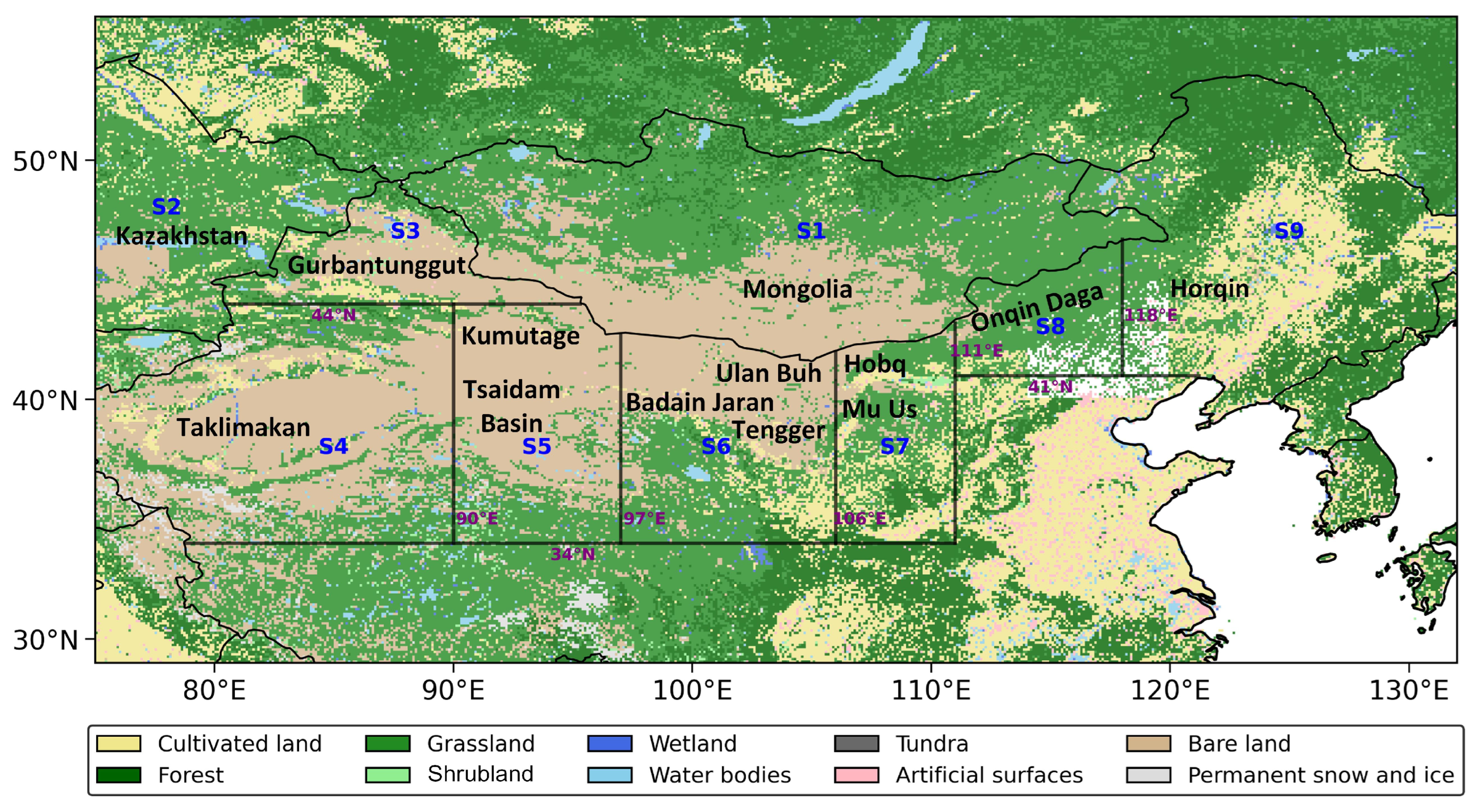

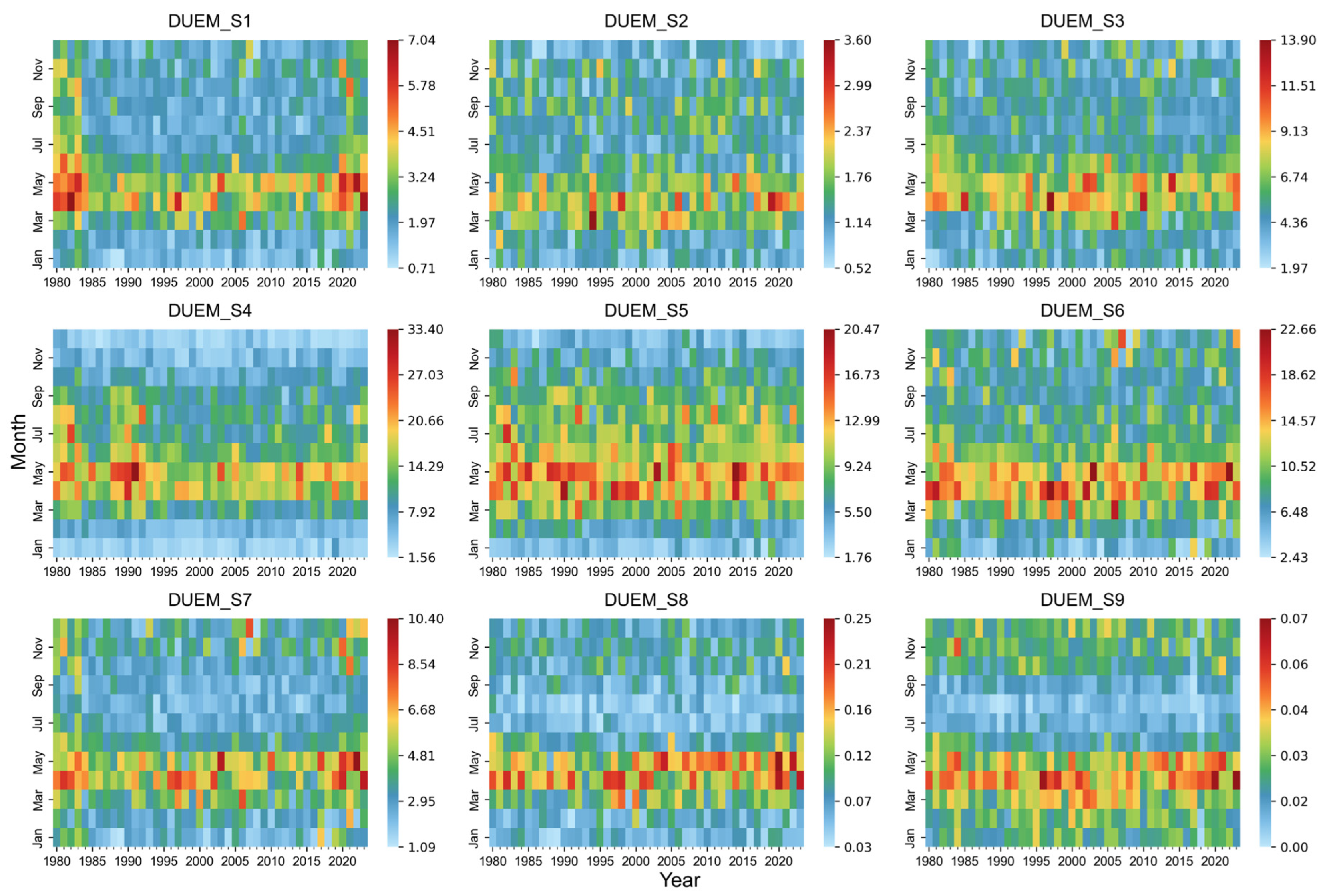
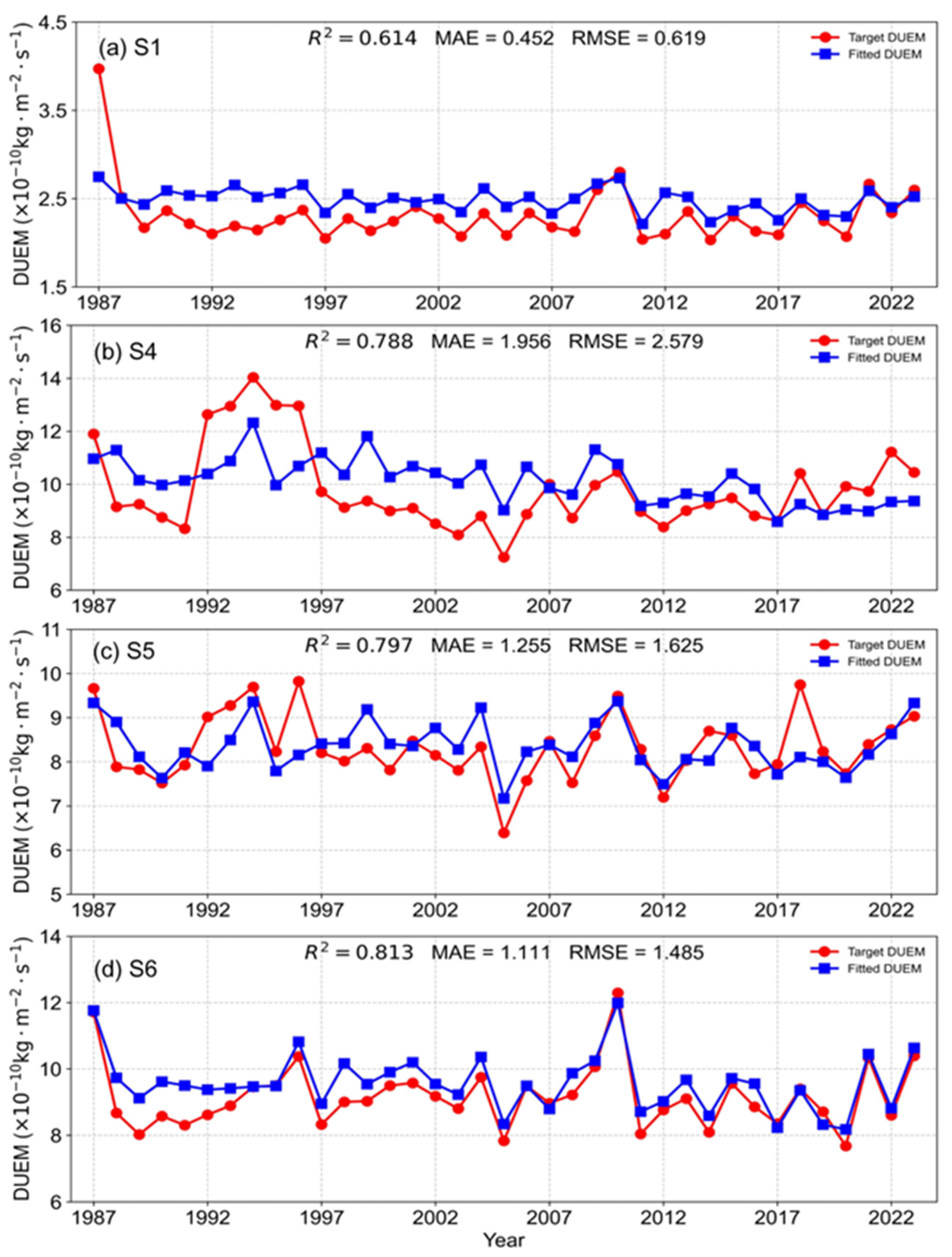
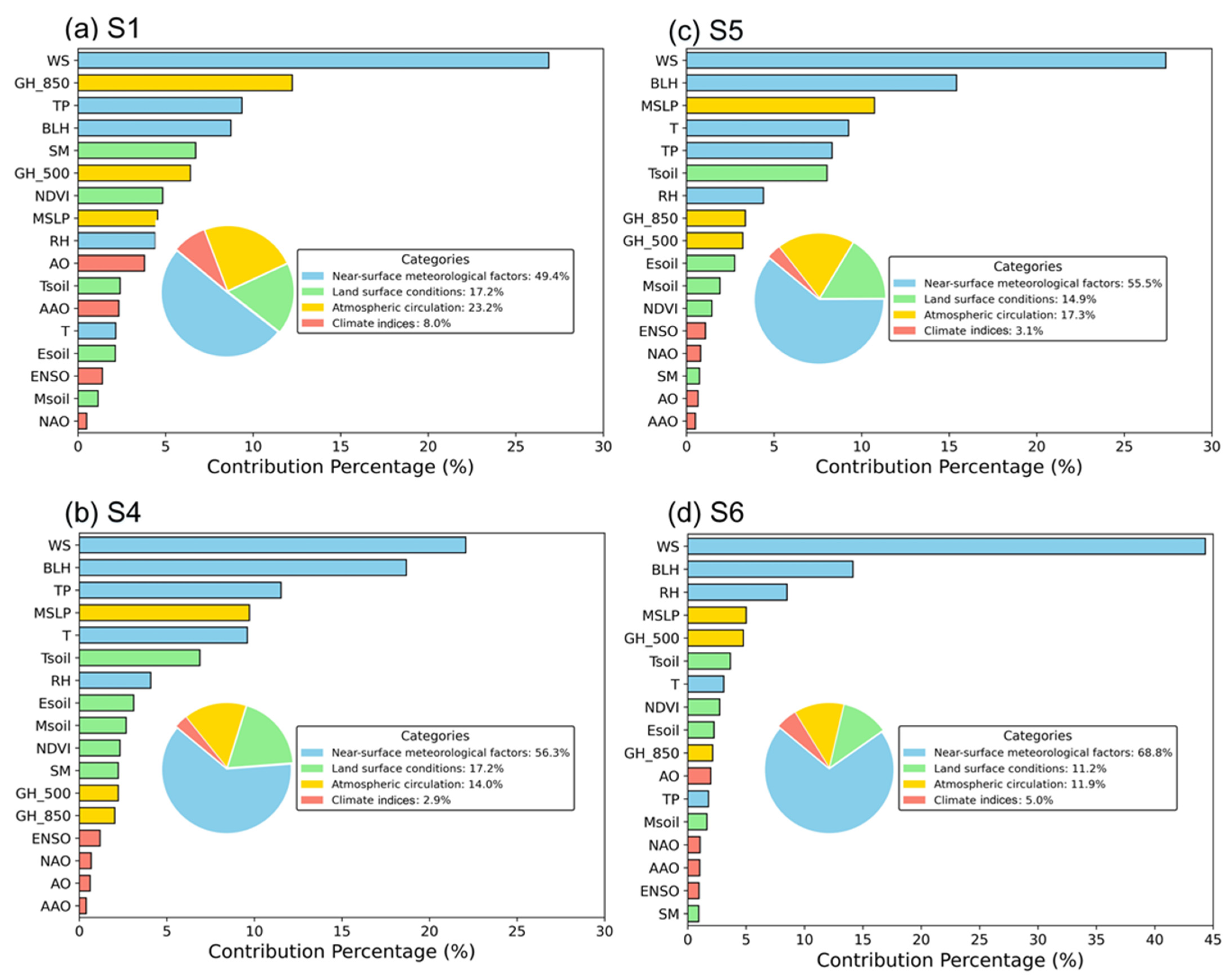

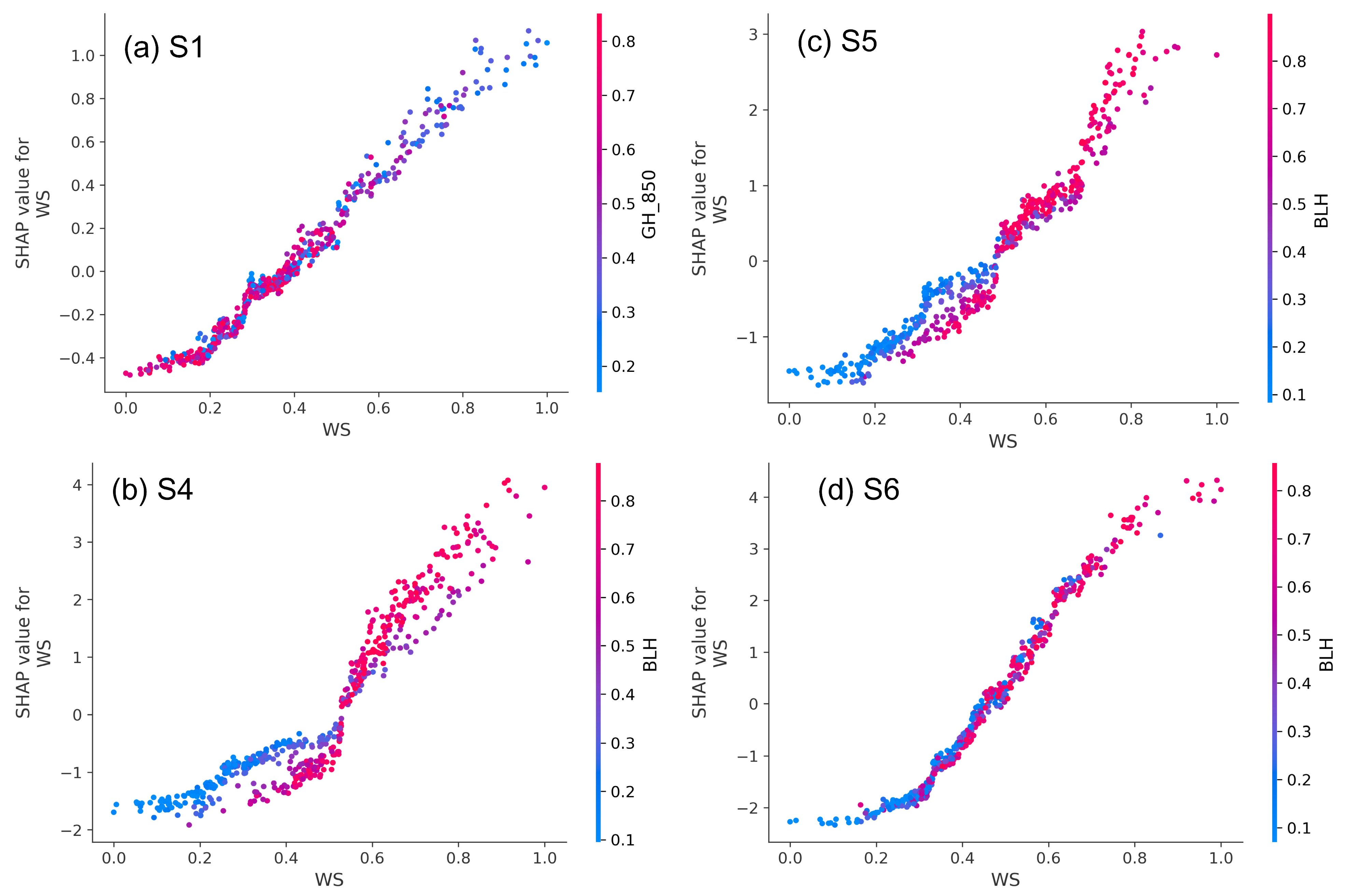
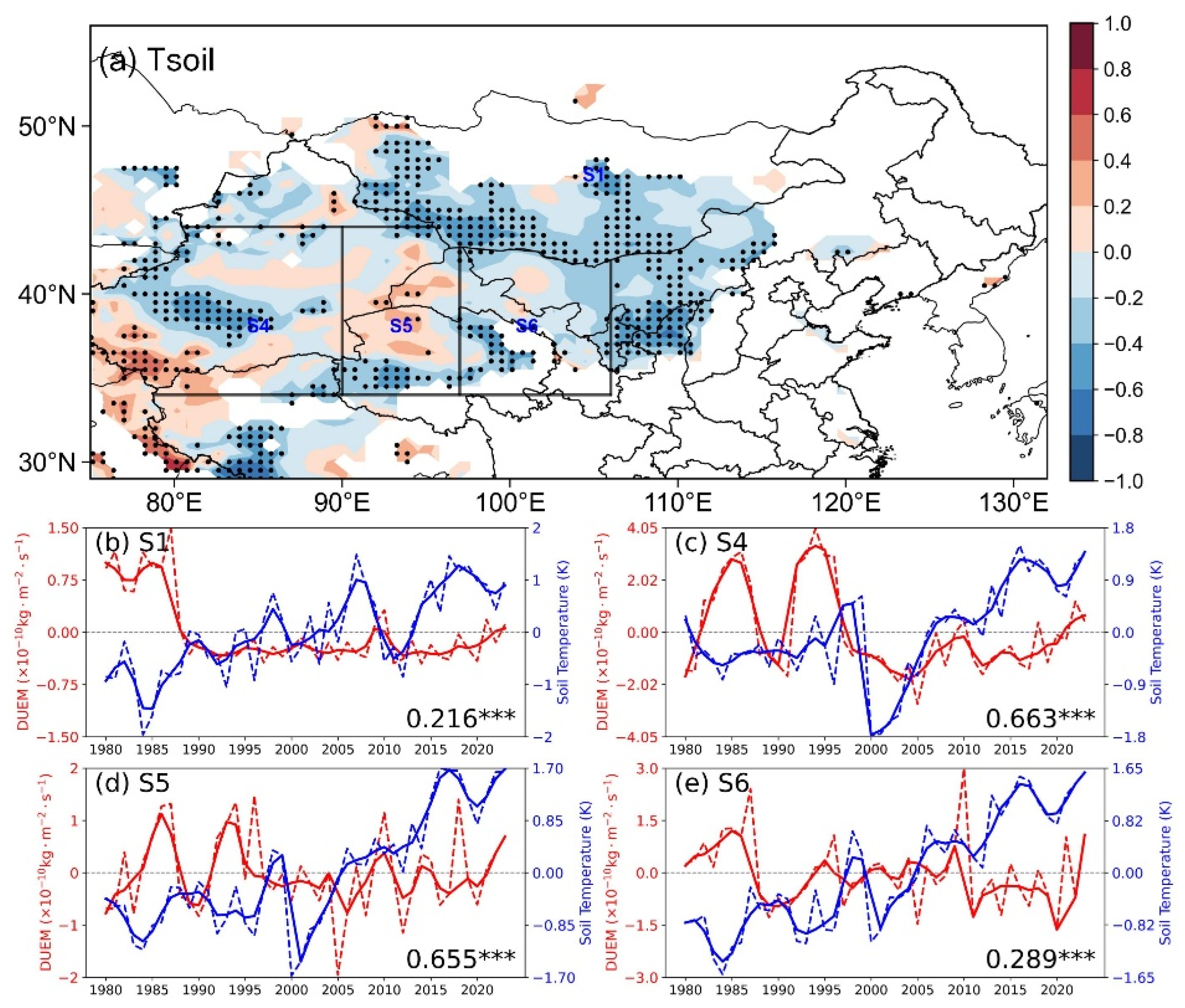
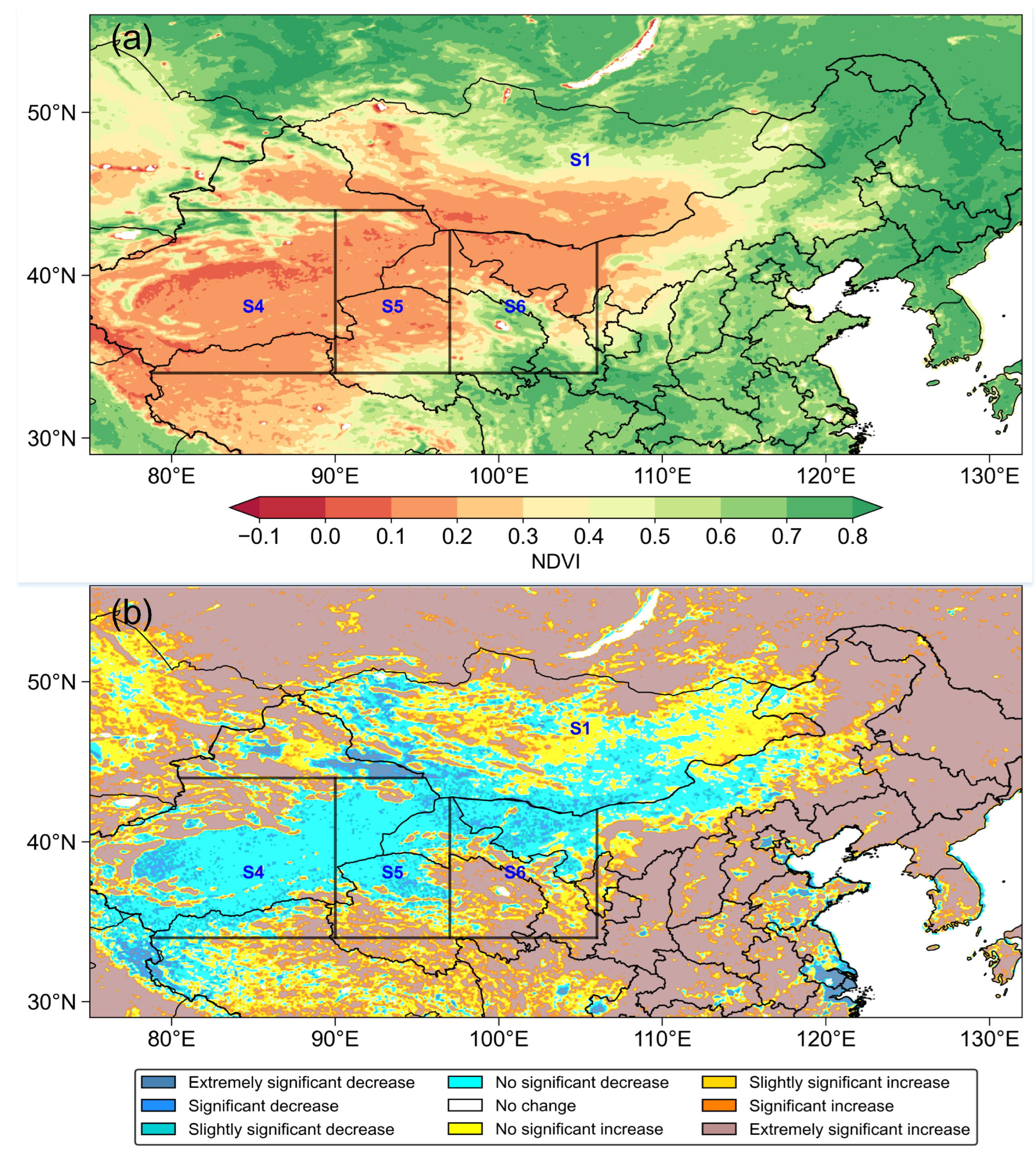
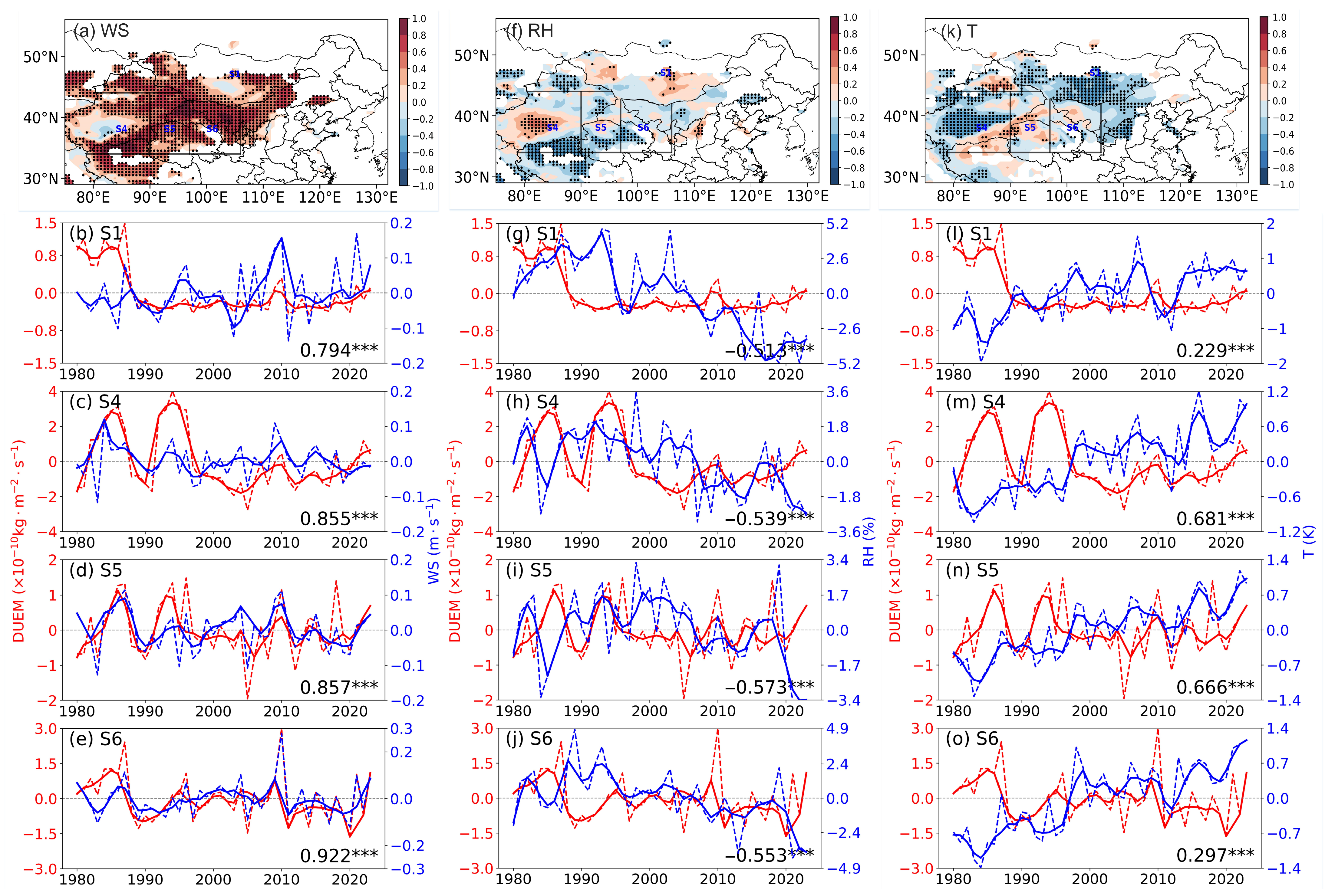


| Label | Z Value | Trend Categories |
|---|---|---|
| β > 0 | Z > 2.58 | Extremely significant increase |
| 1.96 ≤ Z ≤ 2.58 | Significant increase | |
| 1.65 ≤ Z ≤ 1.96 | Slightly significant increase | |
| Z ≤ 1.65 | No significant increase | |
| β = 0 | Z | No change |
| β < 0 | Z ≤ 1.65 | No significant decrease |
| 1.65 < Z ≤ 1.96 | Slightly significant decrease | |
| 1.96 < Z ≤ 2.58 | Significant decrease | |
| Z > 2.58 | Extremely significant decrease |
| Driving Factor | Variables | S1 | S4 | S5 | S6 |
|---|---|---|---|---|---|
| Land surface conditions | Esoil | 0.232 *** | 0.615 *** | 0.498 *** | 0.213 *** |
| Tsoil | 0.216 *** | 0.663 *** | 0.655 *** | 0.289 *** | |
| Msoil | −0.012 | 0.252 *** | 0.113 | −0.062 | |
| SM | 0.527 *** | 0.719 *** | 0.508 *** | 0.211 *** | |
| NDVI | −0.112 *** | −0.393 *** | −0.271 *** | −0.064 | |
| BLH | 0.521 *** | 0.799 *** | 0.782 *** | 0.560 *** | |
| Near-surface meteorological factors | WS | 0.794 *** | 0.855 *** | 0.857 *** | 0.922 *** |
| RH | −0.513 *** | −0.539 *** | −0.573 *** | −0.553 *** | |
| T | 0.229 *** | 0.681 *** | 0.666 *** | 0.297 *** | |
| TP | 0.316 ** | 0.695 *** | 0.646 *** | 0.178 *** | |
| Atmospheric circulation | MSLP | −0.352 *** | −0.727 *** | −0.714 *** | −0.382 *** |
| GH_500 | −0.522 *** | −0.264 * | −0.188 | −0.253 *** | |
| GH_850 | −0.470 *** | −0.604 *** | −0.629 *** | −0.380 *** |
| Climate Index | S1 | S4 | S5 | S6 |
|---|---|---|---|---|
| AO | −0.576 *** (JFM) | −0.109 (NDJ) | −0.163 (JFM) | −0.567 *** (JFM) |
| NAO | −0.467 *** (JFM) | 0.252 (MAM) | −0.273 * (MAM) | −0.578 *** (JFM) |
| AAO | −0.419 ** (JFM) | 0.268 * (OND) | −0.221 (OND) | −0.344 ** (JFM) |
| ENSO | 0.080 (JFM) | 0.244 (MAM) | 0.201 (NDJ) | −0.144 (MAM) |
Disclaimer/Publisher’s Note: The statements, opinions and data contained in all publications are solely those of the individual author(s) and contributor(s) and not of MDPI and/or the editor(s). MDPI and/or the editor(s) disclaim responsibility for any injury to people or property resulting from any ideas, methods, instructions or products referred to in the content. |
© 2025 by the authors. Licensee MDPI, Basel, Switzerland. This article is an open access article distributed under the terms and conditions of the Creative Commons Attribution (CC BY) license (https://creativecommons.org/licenses/by/4.0/).
Share and Cite
Yi, Z.; Wang, Y.; Zeng, Z.; Li, W.; Che, H.; Zhang, X. Decadal Trends and Drivers of Dust Emissions in East Asia: Integrating Statistical and SHAP-Based Interpretability Approaches. Remote Sens. 2025, 17, 1313. https://doi.org/10.3390/rs17071313
Yi Z, Wang Y, Zeng Z, Li W, Che H, Zhang X. Decadal Trends and Drivers of Dust Emissions in East Asia: Integrating Statistical and SHAP-Based Interpretability Approaches. Remote Sensing. 2025; 17(7):1313. https://doi.org/10.3390/rs17071313
Chicago/Turabian StyleYi, Ziwei, Yaqiang Wang, Zhaoliang Zeng, Weijie Li, Huizheng Che, and Xiaoye Zhang. 2025. "Decadal Trends and Drivers of Dust Emissions in East Asia: Integrating Statistical and SHAP-Based Interpretability Approaches" Remote Sensing 17, no. 7: 1313. https://doi.org/10.3390/rs17071313
APA StyleYi, Z., Wang, Y., Zeng, Z., Li, W., Che, H., & Zhang, X. (2025). Decadal Trends and Drivers of Dust Emissions in East Asia: Integrating Statistical and SHAP-Based Interpretability Approaches. Remote Sensing, 17(7), 1313. https://doi.org/10.3390/rs17071313







